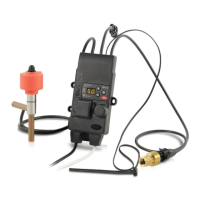13
ENG
“EVD ice” +0300038EN - rel. 1.1 - 23.04.2018
5. FUNCTIONS
A low superheat temperature in fact corresponds to a situation of probable
instability due to the turbulent evaporation process approaching the
measurement point of the probes. The expansion valve must therefore
be controlled with extreme precision and a reaction capacity around
the superheat set point, which will almost always vary from 3 to 14 K.
Set point values outside of this range are quite infrequent and relate to
special applications.
P
E
V
S
F
L
M
T
CP
EEV
S1
S2
Fig. 5.a
Key
CP compressor EEV electronic expansion valve
C condenser V solenoid valve
L liquid receiver E evaporator
F dewatering lter P pressure probe (transducer)
S liquid indicator T temperature probe
For the wiring, see
“Wiring description”
.
5.1 Control
EVD ice is a superheat controller. The type of refrigeration unit can be
selected using the “Operating mode” parameter.
Parameter/description Def.
Operating mode
1 Multiplexed cabinet/cold room
2 Air-conditioner/chiller with plate heat exchanger
3 Air-conditioner/chiller with tube bundle heat exchanger
4 Air-conditioner/chiller with nned coil heat exchanger
5 Reserved
6 Reserved
7 Banco frigo/cella con CO2 (R744) sub-critica
1 = multiple-
xed cabinet/
cold room
Tab. 5.a
Based on the operating mode setting , the driver automatically sets a
series of control parameters.
Operating mode PID: pro-
port. gain
PID: integra-
tion time
Superheat
set point
LowSH protection LOP protection MOP protection
threshold Integra-
tion time
threshold Integra-
tion time
thre-
shold
Integra-
tion time
1 Multiplexed cabinet/cold room 15 150 11 5 15 -50 0 50 20
2 Air-conditioner/chiller with plate heat exchanger 3 40 6 2 2,5 -50 4 50 10
3 Air-conditioner/chiller with tube bundle heat exchanger 5 60 6 2 2,5 -50 4 50 10
4 Air-conditioner/chiller with nned coil heat exchanger 10 100 6 2 10 -50 10 50 20
5 Reserved - - - - - - - - -
6 Reserved - - - - - - - - -
7 Banco frigo/cella con CO2 (R744) sub-critica
20 400 13 7 15 -50 0 50 20
Tab. 5.b
Superheat
The primary purpose of the electronic valve is ensure that the ow-rate
of refrigerant that ows through the nozzle corresponds to the ow-rate
required by the compressor. In this way, the evaporation process will take
place along the entire length of the evaporator and there will be no liquid
at the outlet (consequently in the branch that runs to the compressor). As
liquid is not compressible, it may cause damage to the compressor and even
breakage if the quantity is considerable and the situation lasts some time.
Superheat control
The parameter that the control of the electronic valve is based on is
the superheat temperature, which eectively tells whether or not there
is liquid at the end of the evaporator. The superheat temperature is
calculated as the dierence between: superheated gas temperature
(measured by a temperature probe located at the end of the evaporator)
and the saturated evaporation temperature (calculated based on the
reading of a pressure transducer located at the end of the evaporator and
using the Tsat(P) conversion curve for each refrigerant).
Superheat =
Superheated gas
temperature
(*)
–
Saturated evaporation
temperature
(*) suction
If the superheat temperature is high it means that the evaporation
process is completed well before the end of the evaporator, and therefore
ow-rate of refrigerant through the valve is insucient. This causes a
reduction in cooling eciency due to the failure to exploit part of the
evaporator. The valve must therefore be opened further. Vice-versa, if
the superheat temperature is low it means that the evaporation process
has not concluded at the end of the evaporator and a certain quantity
of liquid will still be present at the inlet to the compressor. The valve
must therefore be closed further. The operating range of the superheat
temperature is limited at the lower end: if the ow-rate through the valve
is excessive the superheat measured will be near 0 K. This indicates the
presence of liquid, even if the percentage of this relative to the gas cannot
be quantied. There is therefore un undetermined risk to the compressor
that must be avoided. Moreover, a high superheat temperature as
mentioned corresponds to an insucient ow-rate of refrigerant. The
superheat temperature must therefore always be greater than 0 K and
have a minimum stable value allowed by the valve-unit system.

